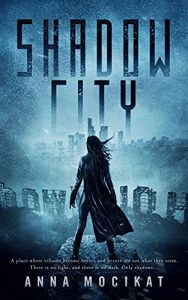Adrian Collins's Blog, page 149
January 12, 2022
The artist making every indie cover glow: Felix Ortiz
A few years back, I was scrolling through the Grimdark Fiction Readers and Writers Facebook group when I spotted a post by an artist who was starting out and looking to get his first cover clients. That artist’s name was Felix Ortiz, and if you fast forward to present day his brilliant cover pieces consistently draw the eye on fantasy bookshelves and social media.
Often brought even further to life by designer Shawn T King‘s works, Ortiz has a style that breathes life into the frozen moment. His works create flow and breathtaking action, and even his more experimental fan art demands you stop scrolling and pay attention to what’s happening on his canvas. Zooming in on his works often reveals further details you missed on first view, making Ortiz’s works well worth spending a few quiet minutes admiring and unpacking the scene. I’m sure many of his clients also revel in his ability to depict the smallest detail of their worlds.
Having recently commissioned Ortiz to complete the artwork for The King Must Fall, join me for a few minutes to appreciate my favourite of his works.
The Madness of Herakles by Matt Larkin
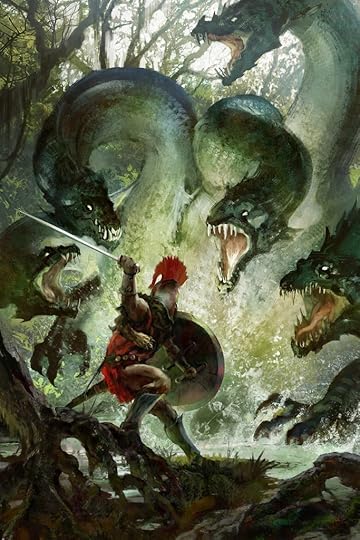
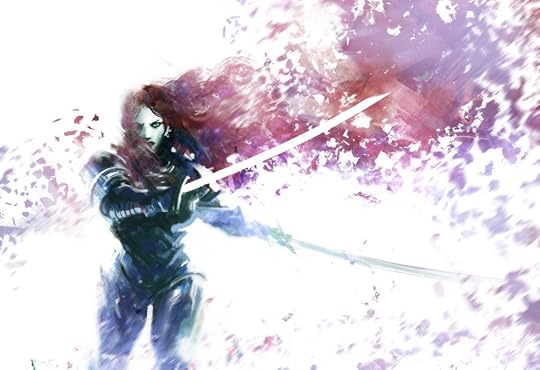
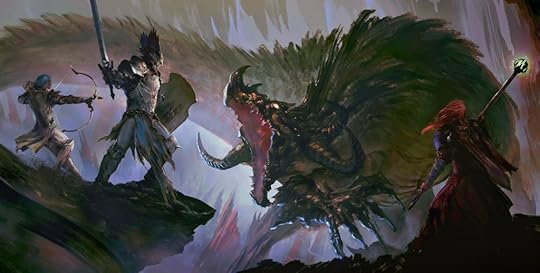
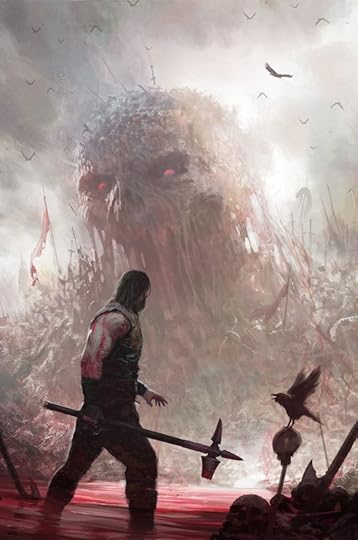
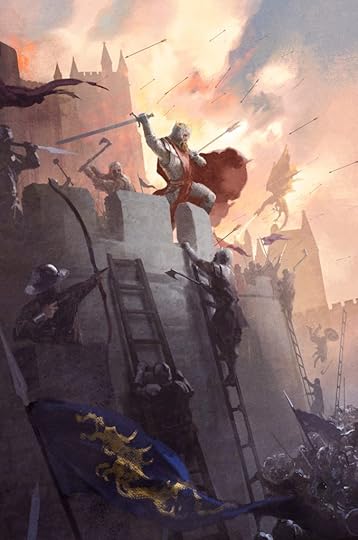
The post The artist making every indie cover glow: Felix Ortiz appeared first on Grimdark Magazine.
REVIEW: The Expanse S6 E3: Force Projection
Force Projection is the third episode of the truncated sixth season of The Expanse and continues the build-up to the final confrontation between Marcos Inaros and the Rocinante crew. In fact, this episode could have been such a confrontation and would have been a satisfying conclusion if not for the fact they pulled back at the last minute.
 The premise is that Marcos has evacuated Ceres station and left them as a humanitarian crisis in the making. They’ve stripped the station of everything valuable and all of their food, leaving only what the people personally possess. Earth now has the decision to feed and clothe the Belters despite their own overstretched resources or leave them to starve, which will only play into Marcos’ cause.
The premise is that Marcos has evacuated Ceres station and left them as a humanitarian crisis in the making. They’ve stripped the station of everything valuable and all of their food, leaving only what the people personally possess. Earth now has the decision to feed and clothe the Belters despite their own overstretched resources or leave them to starve, which will only play into Marcos’ cause.
I happen to like these moments in the Expanse because they reflect real-life terrorist strategies like provoking attacks in order to maximize civilian casualties on your own side. That is one of the best ways to “win hearts and minds” for extremists. Chrisjen Avasarala knows this and is desperate to find a way to break the cycle of violence because so many have died that, right now, it looks like the only solution is genocide to one faction or the other.
Drummer is working on her own attempt to turn the Belter nation against Marcos, which is becoming easier and easier the more the Free Navy proves itself to be a bunch of psychotic scumbags. You’d think the genocide of billions would have already proven that but Marcos’ incompetence and willingness to abandon anyone he doesn’t consider a “true Belter” (which is anyone not utterly loyal to him) is certainly helping her plan.
Filip Inaros continues to question Marcos and starts developing a spine. Unfortunately, it’s a bit late for this character development as he’s crossed the Moral Event Horizon numerous times. It’s a bit like trying to redeem Kylo Ren after he murdered Han Solo, participated in the destruction of Hosnian Prime, and rejected redemption multiple times. Yes, it’s still possible but it’s not nearly as dramatically satisfying as it might be.
The big highlight of the episode, though, is the space battle between Marcos’ flagship and the Rocinante. Marcos is obsessed with killing the man who took away his girlfriend, showed him up repeatedly, and has the audacity to be an Earther who claims to care about Belters. Marcos enters the battle with every advantage but still manages to come within inches of death due to his arrogant belligerance.
Fans are going to debate whether or not Holden made the right decision in sparing Marcos’ life given he’s proven to be an existential threat to not only Earthers but human life in general. However, Holden can’t bring himself to kill Marcos due to the fact it would also kill Naomi’s son Fillip. We’ll see if this act of mercy pays dividends in the end.
Oh and Laconia is now going to give Marcos some more gifts. Uh oh.
In conclusion, the Expanse continues to ramp up the tension as well as deal with the political fallout of the Marcos’ attack on Earth. There’s still a lot of build-up for dealing with the alien threat but there’s no way to handle that in three episodes.
The post REVIEW: The Expanse S6 E3: Force Projection appeared first on Grimdark Magazine.
January 11, 2022
REVIEW: Disappearance of a Scribe by Dana Stabenow
Dana Stabenow’s latest, Disappearance of a Scribe, is a murder mystery set in Ancient Egypt. Which as the local Classics nerd I was very intrigued by from the get go – there are not many historical novels set in Ancient Egypt compared to other periods, and especially not murder mysteries. This is a follow-up to 2018’s Death of an Eye – and I should admit here that I haven’t read the first book, thinking that, like most murder mysteries, this would be fairly standalone. Disappearance of a Scribe is set in the reign of Cleopatra, and takes place in the famed city of Alexandria – though sadly the Great Library is already a relic of the past and not a centre of learning anymore.
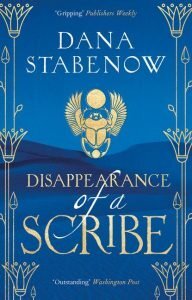 It is a fairly slow-paced mystery, closer to the tradition of Agatha Christie than the ubiquitous James Patterson-type thrillers racing through plot at a breakneck pace. This means there is far more time to focus on characterisation and setting of the story rather than just on the case at hand. It did feel like this is very much settled as part of a series – I think I’d have gotten more out of it if I had read the first book which presumably sets up the central relationship between Cleopatra and her Eye of Isis (a sort of Pharao’s detective), Tetisheri, which goes in with the book’s general feeling of being character-focused, with the mystery being a sort of vehicle to display these characters and their relationships on.
It is a fairly slow-paced mystery, closer to the tradition of Agatha Christie than the ubiquitous James Patterson-type thrillers racing through plot at a breakneck pace. This means there is far more time to focus on characterisation and setting of the story rather than just on the case at hand. It did feel like this is very much settled as part of a series – I think I’d have gotten more out of it if I had read the first book which presumably sets up the central relationship between Cleopatra and her Eye of Isis (a sort of Pharao’s detective), Tetisheri, which goes in with the book’s general feeling of being character-focused, with the mystery being a sort of vehicle to display these characters and their relationships on.
I did feel like I would have preferred a bit more action – as a whole, Disappearance of a Scribe felt like it didn’t give me quite what it advertised itself as. I went in expecting an investigation, a case, and got a story that was more of a historical novel than anything else. I think this one may not be a great choice for the grimdark audience, as it ultimately does not go into enough depth to captivate an audience there for the plot and the gritty happenings. One thing I did enjoy very much was how far politics were ultimately intertwined with the murders that happen, and how the book refused to fall into stereotypes we expect from the period, especially when it comes to the treatment of women. Cleopatra isn’t an exceptional woman, she is merely one in power, and one who empowers her fellow women – and in this Ancient Egypt, women are more than capable of being antagonists as well.
Read Disappearance of a Scribe by Dana Stabenow
The post REVIEW: Disappearance of a Scribe by Dana Stabenow appeared first on Grimdark Magazine.
Review: The Witcher Season 2 Episode 6: Dear Friend
Tensions are flaring between the elves and the Nilfgaardians in Cintra, or Xintrea, as the elves call it. Cahir seems intent on kickstarting hostility between them, even as the elves welcome the first pure-blood elf in some time. Rience portals in on Triss and Vesemir and is seemingly repelled, but has managed to swipe the vial that could make more Witchers, and contains Ciri’s blood.
 But the real meat of the episode is at the Temple of Meletite. Geralt takes Ciri there while looking for answers. It’s the place he was taught how to sign. And it’s clear from his relaxed stance in there—different from nearly everywhere he’s been except, perhaps, Kaer Morhen—that this was always a place of comfort for him.
But the real meat of the episode is at the Temple of Meletite. Geralt takes Ciri there while looking for answers. It’s the place he was taught how to sign. And it’s clear from his relaxed stance in there—different from nearly everywhere he’s been except, perhaps, Kaer Morhen—that this was always a place of comfort for him.
Nenneke, the woman who runs it, is the most benevolent, generous, and wise person we’ve seen on this show. It’s always great when a show so filled with sadists, schemers and scoundrels can bring in someone so good, as a counterbalance, without it feeling like we’ve stepped into a different show.
And then the show brings all three of our major characters together, for the first time since the show began. Ciri, Yennefer, and Geralt all meet—the former walking in on the latter characters kissing. Geralt had, until last episode, assumed Yennefer was dead after Sodden.
As was hinted at in the last recap, though, Yennefer’s not there for Geralt, or just by happenstance. The trade she offered to get her magic back is to bring Ciri to a shattered door outside Cintra. She had no idea who Ciri was, or that she was Geralt’s Child of Surprise, but she made a deal with a powerful entity and she cannot back out. She’ll happily play the long-lost lover to Geralt, and it’s genuine, but there’s always more behind the surface.
 This is followed up with one of the best action sequences the show has done. Rience comes after Ciri in the Temple of Meletiti with a host of soldiers. Rience goes after Yennefer and Ciri while the soldiers delay Geralt. It’s not tense like the fight against the Bruxa in episode 1, or the Striga back in season 1. It’s just Geralt versus a lot of mooks, which the show has done before, but never to such excellent effect. It shows just how improved over regular humans a Witcher really is. The combination of signs and his improved speed and reflexes make it a brutal, perfect combat sequence.
This is followed up with one of the best action sequences the show has done. Rience comes after Ciri in the Temple of Meletiti with a host of soldiers. Rience goes after Yennefer and Ciri while the soldiers delay Geralt. It’s not tense like the fight against the Bruxa in episode 1, or the Striga back in season 1. It’s just Geralt versus a lot of mooks, which the show has done before, but never to such excellent effect. It shows just how improved over regular humans a Witcher really is. The combination of signs and his improved speed and reflexes make it a brutal, perfect combat sequence.
He is, however, delayed just long enough for Yennefer to ‘rescue’ Ciri. Ciri trusts Geralt, Geralt trusts Yennefer, and Yennefer uses that to convince Ciri to flee with her, getting the young woman to open up a portal and step through just as Geralt reaches them.
The post Review: The Witcher Season 2 Episode 6: Dear Friend appeared first on Grimdark Magazine.
January 10, 2022
REVIEW: Shadow City by Anna Mocikat
Shadow City by Anna Mocikat is first volume of her Tales of the Shadow City chronicles that is a genre busting post-apocalypse adventure story. I can’t really think of any other novels like it with its mixture of monsters, cyborgs, the supernatural, and survival horror. If I had to make a comparison, it reminds me of both Ex-Heroes by Peter Clines crossed with the Fallout games. Except instead of 1950s Americana, Anna Mocikat draws from The Matrix-style Nineties antiheroes.
The premise is that an event called the Glitch occurred and caused the entire world to be bathed in a long hot night that never ends. The laws of physics and reality seem bent with much of humanity becoming mindless feral mutants under the control of body-hopping aliens called the Dark Ones. Thankfully, humanity has the benefit of vampires to protect them. Yes, vampires. Except the vampires are pretty lazy and are only doing this to protect their food supply. There’s also a mysterious “Academy” that provides advanced cybernetic soldiers to protect humanity’s few remaining strongholds despite the lack of resources affecting everyone.
This surreal environment is where naked and confused human (?) Colton finds himself. Stronger, smarter, and faster than any human, Colton is also completely unaware of anything that has happened since before the Glitch. He takes virtually everything in stride, though, and swiftly develops a bond with the local survivor community. The human survivors are sick of being forced to depend on vampires for protection and think a human defender would be good for morale.
The world-building feels like it could be a very good open-world RPG with lots of ruins, familiar sights, and horrible dangers lurking around every corner. Anna Mocikat’s background as a game developer shines true here and it definitely feels like the kind of place I would enjoy visiting with my fellow gamers in multiplayer. That doesn’t mean it doesn’t work as the basis for her action-horror-post-apocalyptic sci-fi fantasy, though. The world-building follows a surreal dream-like logic that makes everything make sense in its own internal structure even if you wonder why Robocop and Dracula are fighting with starving scavengers.
Of the many characters throughout the book, I think I prefer Eurydice the most. She’s actually one of the villains who is willingly working with the Dark Ones toward the extinction of humanity. With that kind of goal, you have to work hard to make a character still entertaining. Nevertheless, she manages to be sexy and entertaining the entire time. Probably because she absolutely does not care in the slightest about any of the humans surviving due to her own snarky misanthropy as well as somewhat suicidal nihilism.
There’s a nice mix of characters beyond Colton and Eurydice with everything from body swapping aliens to Bombshell the snarky cyborg enforcer. We also get a sense of how people are coping with the fact they have to be regular donors to the local vampires as well as live under their rule (answer: badly). I was, unfortunately, annoyed the only religious people in the post-apocalyse world are the usual fanatical morons who are just detestable fools. Even when actual demons and angels are fighting in the background.
In conclusion, Shadow City is a deeply entertaining dark fantasy horror setting that would make a very good video game. It has likable characters and a somewhat LIT-RPG-esque feel without the stats. I wouldn’t precisely call this cyberpunk but its definitely got cyberpunk elements and a little something for everyone.
Read Shadow City by Anna Mocikat
The post REVIEW: Shadow City by Anna Mocikat appeared first on Grimdark Magazine.
REVIEW: The Expanse S6 E2: Azure Dragon
The Expanse remains one of my all time favorite genre shows and is easily the only one that stands up to Game of Thrones in any sort of artistic or production value capacity. It also seems to be sticking to the landing considerably better. Mind you, it’s stopping a couple of books short but the Expanse novels have always been more self-contained than the works of George R.R. Martin. They’ve also been completed with the recent release of Leviathan Falls. Either way, I think most fans will be content with the way the story is being set up to include.
 Ironically, the weirdest thing about Azure Dragon is the fact it’s setting up a bunch of elements from the final two books that the remaining four episodes have no way of resolving. They are adapting the story of the novella “Strange Dogs” and that is meant to apply to the Laconia plot that is, bluntly, resolved in the two books they are not adapting.
Ironically, the weirdest thing about Azure Dragon is the fact it’s setting up a bunch of elements from the final two books that the remaining four episodes have no way of resolving. They are adapting the story of the novella “Strange Dogs” and that is meant to apply to the Laconia plot that is, bluntly, resolved in the two books they are not adapting.
In this case, we get a nice bio-physics lesson with the episode opening up with a young girl discovering that the animal life of Laconia can’t digest the food from Earth. Likewise, human beings are incapable of digesting the life found on Laconia. Really, the Protomolecule aliens gave us a bum set of goods since they gave us a bunch of inhabitable planets that are extremely hostile to live upon. Still, I’ve always liked these details as it means we’ll never have to worry about being invaded by aliens since our world is utterly uninhabitable to any differently evolved species.
We also get to see Marcos bail out his son, Filip, from murdering his best friend in a drunken rage. It’s one of the few times that we actually see the otherwise perpetually affable Marcos genuinely furious and disappointed with his son. It’s also one of the even rarer cases where he’s entirely justified. Filip is a character who has participated in the murder of millions, if not billions, and would be irredeemable if not for the fact he seems at least vaguely aware what he’s done is wrong. Still, he’s so repulsive that its hard to feel like he deserves a second chance.
Bobbie rejoins the Rocinate crew this episode and it’s hilarious to see the difference in her attitude compared to the ragged crew after months on the frontlines. Bobbie is suddenly the chipper one and having justifiable confusion at the presence of former archenemy Clarissa Mao onboard the ship. It also nicely foreshadows more plots that go beyond Marcos Inaros, which, again, is confusing given this is meant to be the last season. What is eating those colony ships? We may never find out!
The actual attack on the Azure Dragon, one of the Free Navy’s most powerful vessels, is thrilling and used for emotion as well as spectacle. Naomi being unable to deal with the memories of her last time on a Free Navy vessel while Clarissa picking up the slack is particularly notable. She is becoming a true member of the crew and that is great to see.
The episode is full of action, suspense, and character development but we’re still far from getting Marcos finally dealt with. He’s such a deliciously hateable villain that I am really looking forward to his end and things settling into a new status quo. The Expanse has made numerous changes from the books but, generally, has stuck to their spirit and they remain one of the few shows I think actually improved on their source material’s plot.
The post REVIEW: The Expanse S6 E2: Azure Dragon appeared first on Grimdark Magazine.
January 9, 2022
REVIEW: Where the Drowned Girls Go by Seanan McGuire
There is a lot of magic in Seanan McGuire‘s Wayward Children series and her newest addition, Where the Drowned Girls Go. Magic in the characters’ hearts and magic in the worlds and doors she has built. And that magic comes through in every lyrical word spoken by the characters. It is an impressive feat to be this far into a series, book 7 to be exact, and still be impressed by the story. But I very much am.
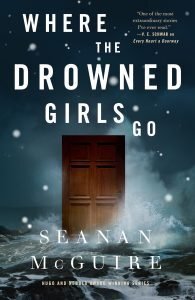 While novels have a long time to tell a story, it has a chance to zig-zag, twist, and curl around, coming to a climax that is 400 or 500 pages in the making; novellas aren’t like that. They do not have the luxury and word count to dance around. They need to be tight where every word is a choice, and every character’s action is exacting. This tightness is why this particular series is so powerful. McGuire tells a lot, builds whole worlds behind hidden doors with a short page and word count.
While novels have a long time to tell a story, it has a chance to zig-zag, twist, and curl around, coming to a climax that is 400 or 500 pages in the making; novellas aren’t like that. They do not have the luxury and word count to dance around. They need to be tight where every word is a choice, and every character’s action is exacting. This tightness is why this particular series is so powerful. McGuire tells a lot, builds whole worlds behind hidden doors with a short page and word count.
The seventh book of the series, Where the Drowned Girls Go, builds a world, but it isn’t behind a door but at a new facility. Instead, McGuire creates The Whitethorn Institute, A school that is the antithesis of Eleanor West’s Home for Wayward Children. There are old characters that readers of the series have gotten quite fond of and new ones to meet and get to know.
Cora, a girl who has gone through a door and returned, is desperate for change. She is desperate to move on. However, The Drowned Gods of the Moors have her number and torment her nightly, begging her to give herself over to them—something she will not do. Cora decides that the only way to get away from them is a drastic change. She leaves Home For Wayward Children to The Whitethorn Institute.
Mcguire was able to describe The Whitethorn Institute in very few words. For me, it resembled a “therapeutic” Boarding school for Problem Children that use questionable methods. Cora decides that she needs to go there and forget because The Whitethorn Institute teaches you to forget.
It is not what she imagined it to be. The school is much, much worse.
This story has many themes, very much like the other books in the series that adolescents and adults face in their lives. Where the Drowned Girls Go deals with self-image, weight, and bullying. And much like the other books, McGuire does not bash the reader of the head with the themes. Instead, she weaves them into the story, so they make up the story’s fabric. I left Where the Drowned Girls Go, remembering my issues with bullying as a child and an appreciation for Cora as a character.
In conclusion, check out Where the Drowned Girls Go but only if you have read the entire series. Reading the first six books gives you a full appreciation for the worlds McGuire has created and a heightened enjoyment of Where the Drowned Girls Go. There is true beauty in McGuires writing, and the Wayward Children Series can take you out of this world and through the doors into new ones.
Read Where the Drowned Girls Go by Seanan McGuire
The post REVIEW: Where the Drowned Girls Go by Seanan McGuire appeared first on Grimdark Magazine.
REVIEW: The Witcher Season 2 Episode 5: Turn Your Back
This is a bit of an odd episode, in that it’s mostly focused on team-ups between characters who haven’t shared a ton of screen-time: Istredd and Geralt, Yennefer and Jaskier, Ciri and Vesemir.
 We start with Rience, a mage who has been trapped in a deuterium prison for a decade, who is allowed out if he can capture Ciri, though who he’s supposed to capture her for remains unclear. Rience is a torture-happy fire mage, and he seems able to control it even though that same kind of magic burned out Yennefer’s entire ability to do magic.
We start with Rience, a mage who has been trapped in a deuterium prison for a decade, who is allowed out if he can capture Ciri, though who he’s supposed to capture her for remains unclear. Rience is a torture-happy fire mage, and he seems able to control it even though that same kind of magic burned out Yennefer’s entire ability to do magic.
Ciri seems barely interested in Triss’s magic lessons, but becomes fascinated when she finds out that she may carry the key to making more Witchers. She clearly idolizes Geralt, and there’s an obvious subtext regarding her fear of not being capable of defending herself.
As to why Vesemir is willing to possibly try out the formula on Ciri, it’s true that she asks for it and it’s true that he’s done it to other children to make more Witchers. You can understand his desperation for more of the only family he’s known, especially as he ages. But it still seems reckless to likely kill the one with the bloodline necessary for more, given that few of the children ever survive to become Witchers. This plotline could have been improved by making it Ciri trying to sneak in to get the formula, rather than an old man who should know better trying to use it on her.
Istredd, Yennefer’s non-Geralt romantic interest from Season 1, spends some time with Geralt, who wants to know about the destruction of the stellacite monolith. They investigate and find a massive chasm heading into the earth. Their discussions tend to lead towards more lore questions relating to how the Witcher universe was created, and what the Conjunction really was. I’ve always appreciated the use of science in this setting, and Geralt and Istredd seem like scholars of different scientific branches.
Even when Istredd mentions Yennefer and that he loved her, Geralt doesn’t show much jealousy. The turning point is when Istredd mentions that Yennefer is still alive after the Battle of Sodden. Cavill plays Geralt close to the chest, even more so this season than in S1, but that moment he seems to really come alive without losing Geralt’s closed-off nature.
Yennefer and Jaskier have, again, the best dynamic of the episode. Despite not truly liking each other, Jaskier helped her out in the last episode, and Yennefer got off the boat to Cintra once she thought he was in trouble. Jaskier is captured by Rience and tortured with fire magic. Yennefer should not be a match for a mage without her own magic, but she’s clever, and he’s arrogant, and she knows exactly how his magic works and how to play him. It’s a short action scene, but it’s very much in-character.
Her rescue of him ends up getting her captured, which gives the Deathless Mother she met back in episode 2 the opportunity to re-open her offer. While she still has no magic, she is allowed back into the Deathless Mother’s hut, an easy escape from the guards who had captured her. The Deathless Mother can’t give her magic back directly, and Yennefer outright states she doesn’t want to be indebted, but there is a trade, which we’ll get into in the next recap.
The post REVIEW: The Witcher Season 2 Episode 5: Turn Your Back appeared first on Grimdark Magazine.
January 8, 2022
REVIEW: Leviathan Falls by James S.A. Corey
Leviathan Falls is the ninth book and conclusion of The Expanse series that has successfully gone on to become a roleplaying game, television show, and the basis of numerous spin off novellas. It is the story of a complicated future where Earth, Mars, and the miners in the Asteroid Belt are all struggling for dwindling resources when a mysterious alien artifact changes the course of human history forever. From there, wars and upheaval are primarily determined by the plucky crew of the Rocinante.
 Things are not good for the crew after the events of the previous book. Despite delivering what they hoped would be a knock-out blow to the Laconian Empire, they instead have found the latter able to project its power throughout the galaxy by terrifying humans with threats or orbital bombardment. Unfortunately, Laconia has become the least of humanity’s problems due to the fact the Gotha (extra-dimensional aliens with godlike power) are really ticked off at humanity for their continued use of the protomolecule gates.
Things are not good for the crew after the events of the previous book. Despite delivering what they hoped would be a knock-out blow to the Laconian Empire, they instead have found the latter able to project its power throughout the galaxy by terrifying humans with threats or orbital bombardment. Unfortunately, Laconia has become the least of humanity’s problems due to the fact the Gotha (extra-dimensional aliens with godlike power) are really ticked off at humanity for their continued use of the protomolecule gates.
Duarte may actually prove to be the solution given he’s returned from his coma as someone almost completely merged with the protomolecule. Can he utilize the protomolecule as a weapon against the beings who wiped out the protomolecule’s creators? Should he? Holden and company become, once more, at the center of things due to the fact they have both Duarte’s daughter Theresa as well as one of the few protomolecule infected human beings who remains alive as well as sane.
Hunting our party of space heroes is Colonel Tanaka, the beautiful but fascist chief soldier of Laconia. After a brief encounter with Holden in Egypt, she loses the beautiful part and becomes obsessed with avenging her failure to kill him. As a source of tension, Colonel Tanaka works well and actually has an interesting story arc. She’s still an awful-awful person but is understandable and even charming in her own way.
The conflict against enemies who are completely inscrutable and cannot be opposed by anything humans have technological capacity to produce is something that is a hard story to tell but James S.A. Corey manages to succeed. Part of this is due to the fact they focus on the human element. The protagonists are desperate for a solution but are aware that Laconia and Duarte’s plans are outright insane. As the kind of physics-defying events keep piling up, the climax is suitably set up in a way that is both tragic as well as satisfying.
I would have appreciated more insight into how the Betlers, Earthers, Martians, and colonies were getting along in their struggle against the Laconians but that just isn’t what the book is all about. Still, I overall think this book successfully stuck to the landing. While they won’t be adapting it or the Laconian plot to the TV series, it is a satisfying finale to all of the previous books and what they set up.
Read Leviathan Falls by James S.A. Corey
The post REVIEW: Leviathan Falls by James S.A. Corey appeared first on Grimdark Magazine.
January 7, 2022
REVIEW: Book of Night by Holly Black
Featuring one of the most delightfully messed-up main characters I’ve read in a while, Book of Night is both wickedly clever and dangerously entertaining.
[image error]In a world where “quickened” shadows can be shifted according to the wearer’s mood, Charlie Hall’s shadow is disappointingly ordinary. It does not grow, act of its own accord, or shift on its own. That’s a good thing, since she has enough on her plate as it is. The thing is, Charlie Hall has never seen a bad decision that she isn’t willing to make. Con artist, thief, barista, and certified disaster, trouble has a habit of finding Charlie. To be fair, she doesn’t do all that much to avoid it. Ostensibly done with conning and stealing, Charlie nonetheless works in a bar that crime likes to frequent, she dates a man whose day job is cleaning up the messes left by violence, and she has a knack for upsetting the wrong people.
In a world such as that, it is inevitable that Charlie would be sucked back into a life of conning and stealing. This time the stakes are much higher: Charlie has to find a way to hopefully con her way out of a situation where every solution seems to spell death. The entirety of Book of Night is planned pandemonium, and I was hooked.
This is Holly Black’s first foray into adult fantasy, having garnered a huge fanbase in Young Adult fantasy. While Black’s signature twists and turns are present, the relationships are much more established, allowing me to enjoy the nuances of the characters without being distracted by relationship woes. Don’t get me wrong; as with everything else in her life, Charlie’s relationship with her boyfriend Vince follows the path of most resistance. However, the complications lie in the characters themselves, as opposed to their relationship status. In fact, seeing how Charlie interacted with the people around her was an excellent mirror into the morass of her rather messed-up psyche.
The story is sprinkled with scenes from the characters’ pasts, better developing both their personalities and the world. And it is such a cool world! Manipulators of shadows, known as gloamists, use their shadows to grasp at power, some legally and some otherwise. The wielders of power are fantastical, but the way the power is used to manipulate and control is completely familiar and believable.
There is always something going on, but never at the cost of the plot. The twists seemed to come out of nowhere, yet when I traced back the scenes in the book, the clues were right in front of me. The ending is fantastic, perfectly messy, instead of being tied into an overly neat little bow. While there could be a sequel, which I would gladly read, I almost hope that it is a standalone because the ending hit so well. Book of Night is an exciting urban fantasy from an author who can easily conquer any genre she chooses to write in.
Read Book of Night by Holly Black
The post REVIEW: Book of Night by Holly Black appeared first on Grimdark Magazine.

